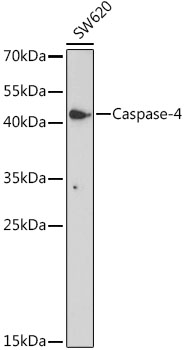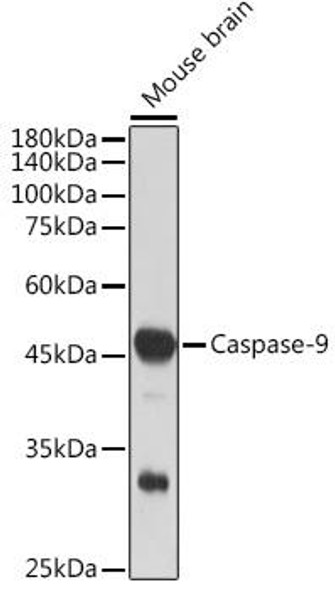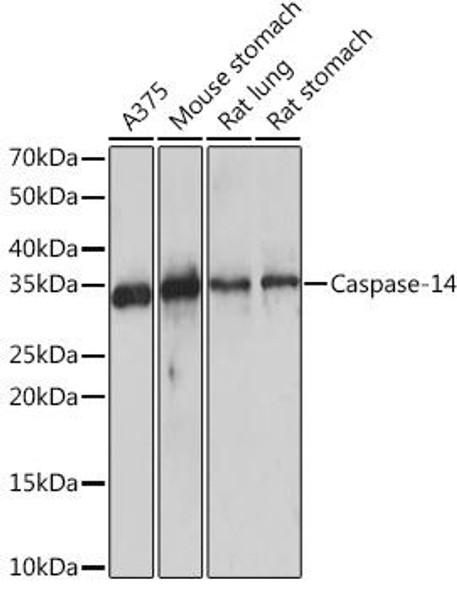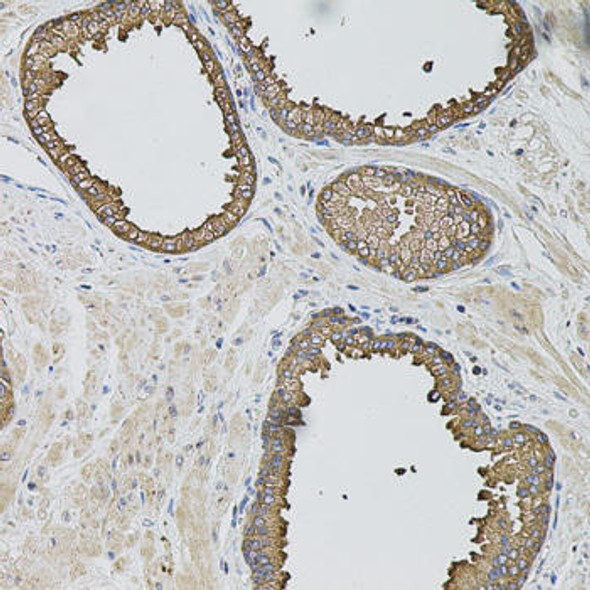Cell Biology Antibodies 15
Anti-Caspase-4 Antibody (CAB19305)
- SKU:
- CAB19305
- Product Type:
- Antibody
- Reactivity:
- Human
- Host Species:
- Rabbit
- Isotype:
- IgG
- Research Area:
- Cell Biology
Description
| Antibody Name: | Anti-Caspase-4 Antibody |
| Antibody SKU: | CAB19305 |
| Antibody Size: | 20uL, 50uL, 100uL |
| Application: | WB IHC |
| Reactivity: | Human |
| Host Species: | Rabbit |
| Immunogen: | Recombinant protein of human Caspase-4. |
| Application: | WB IHC |
| Recommended Dilution: | WB 1:500 - 1:2000 IHC 1:50 - 1:200 |
| Reactivity: | Human |
| Positive Samples: | SW620 |
| Immunogen: | Recombinant protein of human Caspase-4. |
| Purification Method: | Affinity purification |
| Storage Buffer: | Store at -20°C. Avoid freeze / thaw cycles. Buffer: PBS with 0.02% sodium azide, 50% glycerol, pH7.3. |
| Isotype: | IgG |
| Sequence: | Email for sequence |
| Gene ID: | 837 |
| Uniprot: | P49662 |
| Cellular Location: | |
| Calculated MW: | |
| Observed MW: | 43kDa |
| Synonyms: | ICE(rel)II, ICEREL-II, ICH-2, Mih1, Mih1/TX, TX, CASP4 |
| Background: | This gene encodes a protein that is a member of the cysteine-aspartic acid protease (caspase) family. Sequential activation of caspases plays a central role in the execution-phase of cell apoptosis. Caspases exist as inactive proenzymes composed of a prodomain and a large and small protease subunit. Activation of caspases requires proteolytic processing at conserved internal aspartic residues to generate a heterodimeric enzyme consisting of the large and small subunits. This caspase is able to cleave and activate its own precursor protein, as well as caspase 1 precursor. When overexpressed, this gene induces cell apoptosis. Alternative splicing results in transcript variants encoding distinct isoforms. [provided by RefSeq, Jul 2008] |
| UniProt Protein Function: | CASP4: Involved in the activation cascade of caspases responsible for apoptosis execution. Cleaves caspase-1. Heterotetramer that consists of two anti-parallel arranged heterodimers, each one formed by a small and a large subunit. Widely expressed, with highest levels in spleen and lung. Moderate expression in heart and liver, low expression in skeletal muscle, kidney and testis. Not found in the brain. Belongs to the peptidase C14A family. 2 isoforms of the human protein are produced by alternative splicing. |
| UniProt Protein Details: | Protein type:EC 3.4.22.64; Apoptosis; Protease Chromosomal Location of Human Ortholog: 11q22.2-q22.3 Cellular Component: endoplasmic reticulum; endoplasmic reticulum membrane; mitochondrion Biological Process: apoptosis; proteolysis; regulation of apoptosis; regulation of inflammatory response |
| NCBI Summary: | This gene encodes a protein that is a member of the cysteine-aspartic acid protease (caspase) family. Sequential activation of caspases plays a central role in the execution-phase of cell apoptosis. Caspases exist as inactive proenzymes composed of a prodomain and a large and small protease subunit. Activation of caspases requires proteolytic processing at conserved internal aspartic residues to generate a heterodimeric enzyme consisting of the large and small subunits. This caspase is able to cleave and activate its own precursor protein, as well as caspase 1 precursor. When overexpressed, this gene induces cell apoptosis. Alternative splicing results in transcript variants encoding distinct isoforms. [provided by RefSeq, Jul 2008] |
| UniProt Code: | P49662 |
| NCBI GenInfo Identifier: | 1352420 |
| NCBI Gene ID: | 837 |
| NCBI Accession: | P49662.1 |
| UniProt Secondary Accession: | P49662,A2NHL8, A2NHM0, |
| UniProt Related Accession: | P49662 |
| Molecular Weight: | 36,705 Da |
| NCBI Full Name: | Caspase-4 |
| NCBI Synonym Full Names: | caspase 4 |
| NCBI Official Symbol: | CASP4 |
| NCBI Official Synonym Symbols: | TX; ICH-2; Mih1/TX; ICEREL-II; ICE(rel)II |
| NCBI Protein Information: | caspase-4 |
| UniProt Protein Name: | Caspase-4 |
| UniProt Synonym Protein Names: | ICE(rel)-II; Protease ICH-2; Protease TX |
| Protein Family: | Caspase |
| UniProt Gene Name: | CASP4 |
| UniProt Entry Name: | CASP4_HUMAN |







